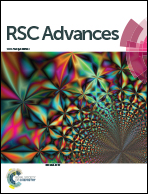A simple route to synthesize hierarchical porous ZrO2†
Abstract
A simple method for preparing porous ZrO2 has been proposed by directly decomposing a Zr(NO3)4·5H2O ethanol sol–gel solution. Contrary to other traditional sol–gel methods, porous ZrO2 with multi-sized macro- and meso-pores are synthesized via only one simple step. The size of the macropores ranges from 100 nm to 500 nm. Remarkably, we also isolated some highly dispersed ZrO2 nanoparticles (∼60 nm), which on their surface or even in the whole body are fully filled with well-sized ever-smaller spherical mesopores with an average diameter around ∼5 nm. A further investigation of low-temperature nitrogen absorption has shown a high surface area over 162 m2 g−1 for the fully crystallized ZrO2. No more additional modifiers or complicated preparations are needed in the present method, which promises a new potential option in fabricating high-porosity materials.


 Please wait while we load your content...
Please wait while we load your content...